Nutraceutical and nutrition industry “resilience” remains steady as recession looms

30 Jan 2023 --- The World Economic Forum (WEF) says that two-thirds of chief economists predict a global recession in 2023 and 18% said that it’s “extremely likely,” a percentage that has doubled since September 2022. Moreover, economic volatility and supply chain disruptions have affected the nutrition and nutraceuticals industry.
PharmaLinea takes us through its industry future forecast and emphasizes steady growth. However, a recent study demonstrates that, due to inflation, many consumers are turning to low-nutrient foods to keep costs low.
“Our industry has proven resilience to various market conditions, including the recession in 2008 when there was only a slight decline in growth. We are now expecting a similar situation. Consumers will, without a doubt, be more prudent when making purchasing decisions, demanding proof of efficacy, and adding value products,” Anton Oražem, CEO at PharmaLinea, tells NutritionInsight.
“However, consumers value their health, so we don’t expect a big decline in growth in our industry, especially for companies that offer products and services with clear added value.”
The WEF also says that not all of the news is bad. “Economists often point to the strength of household finances, slowing inflation and resilient labor markets. The cost-of-living crisis may be reaching its peak, and 68% of the economists say it will be less severe by the end of 2023.” The WEF further details that the energy crisis is expected to improve.
 The price increases for nutraceutical products have been lower than for F&B, Oražem details.Economy and the industry
The price increases for nutraceutical products have been lower than for F&B, Oražem details.Economy and the industry
Oražem says that the global economic situation has affected the nutrition industry in many ways, one of the more notable ones being inflation.
“Interestingly, not all categories have been affected in the same way. In February 2022, inflation rates varied from 4-10%, depending on the category.”
“The data also varies depending on the market. Between January 2021 and October 2022, it shows a 4.5% price increase for multivitamins in Indonesia and a 7.8% increase in South Korea. Meanwhile, the price of multivitamins in Germany has only increased by 0.4%,” he says.
“On the other hand, we can notice a price drop for vitamin D in Indonesia, while in Germany, the price for the same ingredient has increased by 10.4%.”
He further details that the price increase for nutraceutical products has been lower than for food and beverages.
Divided responses, divided markets
Oražem details that consumers’ responses to the economic situation can be divided into two groups.
“On one hand, we have consumers, who are seeking bargains, and on the other hand, an equally large part of those seeking quality, called the hourglass effect and is common in these economic situations. According to our clients, this polarization is leading to clustering in the industry – either brands decide to launch more premium products, or they are launching new products in the price-driven segment.”
Due to this clustering, to succeed in the premium segment, strong USPs (unique selling points) are now “needed more than ever.” He further explains that in 2022, consumer health companies responded to the global economic situation by either increasing the prices of products and services, accepting a lower profit margin or decreasing spending on promotion. Food items at US dollar stores are usually low in nutrients while high in calories.
Food items at US dollar stores are usually low in nutrients while high in calories.
“One of the biggest disruptions in the past year has been the lack of PVDC (polyvinylidene chloride) foil on the global market. Luckily, we managed to secure undisturbed production for our partners despite that. Otherwise, we have done our best to control the supply chain issues by forming strategic partnerships with raw ingredient suppliers and planning needs in advance.”
Compromising on health
A recent study revealed that dollar stores – stores selling various items typically for US$1 – have become the “fastest growing food retailers” nationwide. The study points out that households purchasing more at dollar stores often have a lower income.
Food items at dollar stores are usually high in calories while low in nutrients. The study also points to the store’s footprints, with a growing presence, especially in regions with high rates of obesity and food insecurity – the remote US South.
“Dollar stores play an increasingly important role in household food purchases, yet research on them is lacking. Many localities have established policies such as zoning laws aiming to slow dollar store expansion even though we don’t fully understand the role that they play,” says Wenhui Feng, first author of the paper and assistant professor of public health and community medicine at the US Tufts University School of Medicine.
“Our study is one of the first to use nationally representative data to see the role of dollar stores at the household level,” Feng notes.
 Oražem argues that much of the price increase in the industry has been due to speculation or companies buying ingredients in advance.Oražem says that PharmaLinea plans to support its consumers and partners by assuring undisturbed delivery and by trying not to raise the prices of its products and services.
Oražem argues that much of the price increase in the industry has been due to speculation or companies buying ingredients in advance.Oražem says that PharmaLinea plans to support its consumers and partners by assuring undisturbed delivery and by trying not to raise the prices of its products and services.
“Global trends indicate innovative, clinically supported premium products will prevail in times of economic crisis. Undoubtedly, we can expect a price increase for some ingredients, as they are not exclusively used in the nutraceutical industry but also in other industries. In such cases, our scientific team is well-prepared to adjust product formulations to avoid increasing the prices of finished products for our partners.”
No novelty to volatility
PharmaLinea has already been preparing for this situation for some time since the economic uncertainty in the nutraceutical market is not a novelty, Oražem argues.
“Much of the price increase in the industry has been due to speculation or companies buying ingredients in advance. We are not expecting the supply chain problems to worsen in the future. If anything, we are expecting a slight price decrease.”
“To prepare for the coming year, we have increased our stock and are planning our material needs, as we can expect disturbed delivery for certain ingredients. We have formed partnerships with several ingredient suppliers to ensure undisturbed delivery of raw materials.”
Oražem further details that PharmaLinea is closely following the market trends to see where shortages may appear.
“Although the nutraceutical industry is still quite ‘young,’ a part has already consolidated. This part is mostly strategic suppliers of raw ingredients with stable and strong ownership and professional governance who have sufficient market experience and expertise. We expect they will get through the crisis relatively unaffected,” he concludes.
By Beatrice Wihlander












